16 Types Of Winter Squash And How To Cook Them
Use this guide to make shopping for, prepping, and cooking winter squash easier.
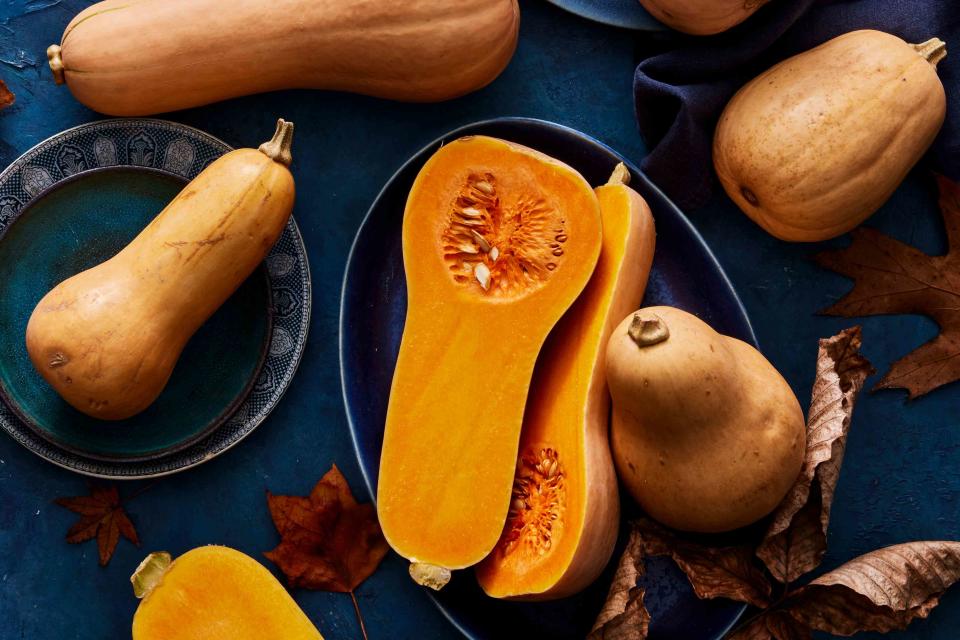
Antonis Achilleos; Prop Stylist: Kathleen Varner; Food Stylist: Chelsea Zimmer
Winter squash come in colors ranging from white to green to red (very festive), some with striping, others with little bumps. They are a diverse group of fruit (yes, they are technically fruit) and even include sugar pumpkins, which are a type of squash best known for their role in pumpkin pie.
In the colder months, winter squash are a staple of farmers' markets, but you're not alone if you're often overwhelmed by all the winter squash varieties offered. Use our guide to learn more about the popular types of winter squash, including how to prep, store, and cook with each.
Related: 17 Winter Squash Recipes To Keep You Warm All Season Long
What To Know When Buying Winter Squash
A good winter squash should be free of any bruises, soft spots, or mold. It should also feel heavy for its size. Some squash will naturally have blemishes or bumps on the skin, which are nothing to worry about. If you knock on a ripe winter squash, it should have a hollow sound, and if the squash has a stem, it should be firm and intact.
How To Store And Prep Winter Squash
Use these tips to store and prep your winter squash properly.
Storage
You'll want to store winter squash in a cold, dry, and dark place. There's no need to refrigerate hearty winter squash until sliced. When stored properly, whole squash should last for two to four months (although it varies by variety). For longer storage, winter squash can be sliced, diced, or pureed, and then frozen for up to eight months.
Related: 7 Types Of Summer Squash And How To Cook With Each
Prep
Although squash skin is technically edible, not all varieties have skin that's super tender and pleasant to eat (we'll get into that with each variety below). Some cooking applications also lend themselves to peeled squash, like silky smooth soup or puree.
This means your first order of business when preparing some winter squash, like thick-skinned butternut, is peeling it. Other times you're free to roast it with the skin on, which can make it easier to remove later. If super tender, like the skin on delicata, it can be eaten along with the flesh. Here's how to prep:
Stabilize the cutting board by resting it on a damp towel.
For tough-skinned squash, use a sharp Y-shaped vegetable peeler to remove tough skin.
Use a sharp knife to cut the ends off the squash.
Cut the squash in half lengthwise.
No matter the variety, you'll have to remove the seeds and pulp from the inner cavity before proceeding with a recipe.
Keep the halves intact, or cut each half into slices, then cut each slice into cubes if desired.
Store cut winter squash in an airtight container in the refrigerator for up to three days.
Don't Toss The Seeds
Winter squash seeds are edible and can be cleaned, roasted, and enjoyed as snack, used as a garnish, or tossed into a salad.
Related: 5 Ways To Cook And Eat Pumpkin Seeds
How To Cook Winter Squash
If you've never worked with a particular type of winter squash, fear not. They're all fairly similar to cook and work with. Often, squash are roasted until tender and soft, which concentrates their natural flavor, but they can also be steamed or microwaved.
How To Roast Winter Squash
Typically you'll see winter squash halved or sliced and then roasted, but you can also roast them in smaller pieces or whole. When working with winter squash, a good sharp knife is always imperative. Prep the squash as described above.
To roast, brush the halves or slices with olive oil or toss cubes with oil.
Place prepared and peeled (if desired) squash halves on a foil-lined baking sheet, cut side down, or spread slices or cubes on the sheet.
Roast at 400°F until tender when pierced with a fork, about 50 minutes for large pieces or 12 minutes for smaller pieces.
Here are a few of our recipes for how to roast common winter squash varieties:
How To Steam Winter Squash
Use smaller winter squash pieces for steaming. In a saucepan with a steamer insert, bring an inch of water to a boil. Add the squash, cover, and steam for 10 to 20 minutes or until tender when pierced with a fork.
How To Microwave Winter Squash
You can cook a whole squash with this method. Before cooking, pierce the skin all over with a fork or knife. Place the squash on a microwave-safe dish, and cook small squash for five minutes and larger squash for 10 minutes or until tender when pierced with a fork. Cook longer at one-minute intervals until tender if needed. Let cool until able to touch and peel off the skin if desired, cut the squash in half, and remove the seeds. Serve as desired.
Popular Types Of Winter Squash
These are 16 types of winter squash you're most likely to encounter at either the grocery store or farmers' market.
Delicata
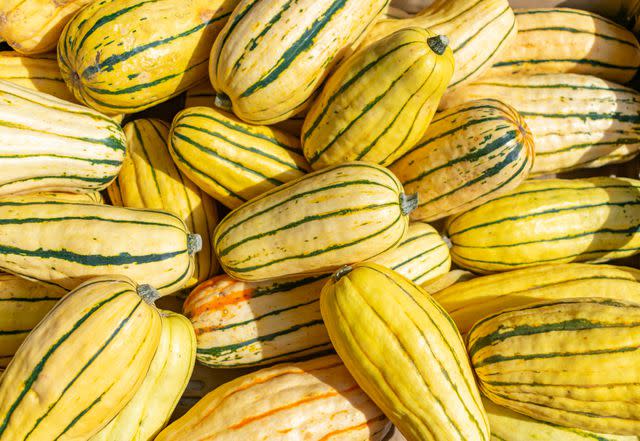
This striped, cylindrical squash has a light-orange interior, and is known for its edible skin. Flavorwise, it has a mild sweetness, strong nuttiness, and starchiness similar to a sweet potato. It's in season between mid-September and early November, but if you can't find it, acorn or butternut squash can be used instead. It's technically the same kind of squash as a sweet dumpling but has an elongated shape in comparison to the shorter, rounder sweet dumpling shape (see below).
Butternut
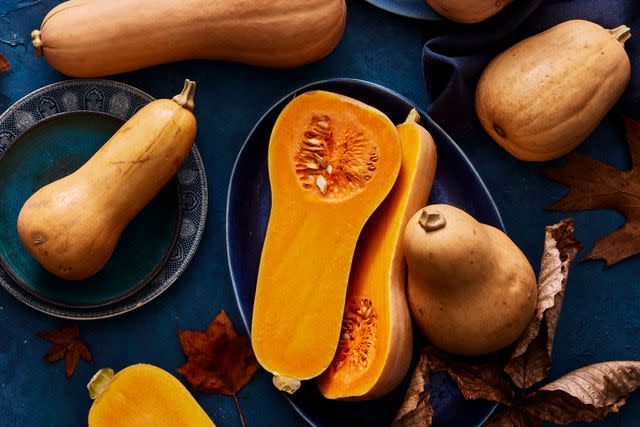
Antonis Achilleos; Prop Stylist: Kathleen Varner; Food Stylist: Chelsea Zimmer
One of the most ubiquitous winter squash, this variety requires a bit of prep work, but it's well worth the effort. The smooth, tan skin should be peeled (it's edible, but tough), and then the seeds should be removed. Like many winter squash, a sharp knife is needed to slice through the firm flesh. After that, it's up to you as to how to cook this versatile variety. It's well-suited to baking, boiling, and steaming, but roasting really concentrates its sweet, nutty flavor.
Related: 9 Butternut Squash Recipes You'll Want To Make This Fall
Buttercup
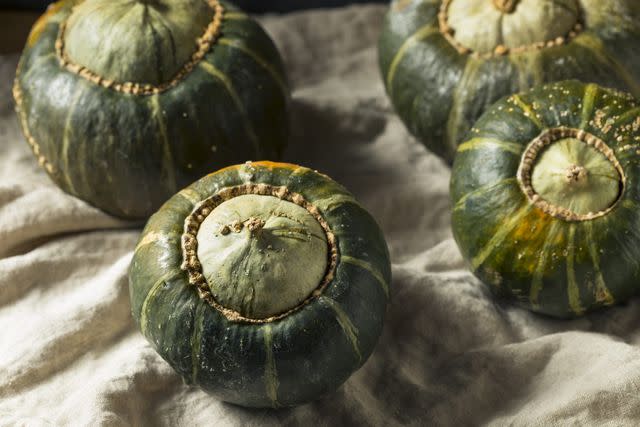
With a sweet name like buttercup, you know this dark green-skinned variety has a rich sweetness. It has a tough skin that's best left intact when roasting, as the flesh can easily be scooped out after cooking. This squatty squash is available throughout the fall and winter, but if you can't find it at your local grocery store, it can easily be substituted with acorn squash.
The "cap" on top should be firm when the fruit is mature and ready to use. This is also a distinguishing feature that can help you tell it apart from similar-looking green kabocha squash at the market. The base of the squash should also have a round ridge, while kabocha will have a button-like base. The skin of a buttercup squash is also smoother, but in truth, the two have very similar flavors, with kabocha having slightly denser flesh.
Honeynut
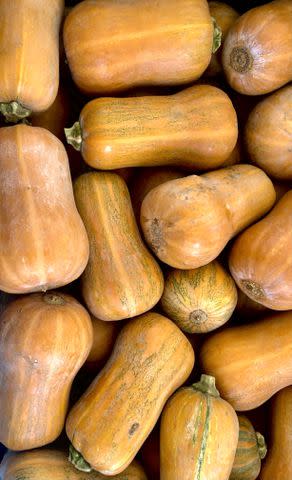
Kathy Feeney/Getty Images
Easily confused with its cousin butternut, honeynut squashes are actually a hybrid of butternut and buttercup squash (which also have similar names, just to make everything a little more confusing). These small winter squash (about half the size of a butternut, but the same shape) have dark tan to orange skin that's thinner than the tough skin found on butternut squash, which means you don't have to peel them. The thin skin has one drawback: They won't last as long as other winter squash, so try to use them up within a few weeks of buying. These squash are also significantly sweeter than butternut, hence honey in the name.
Acorn
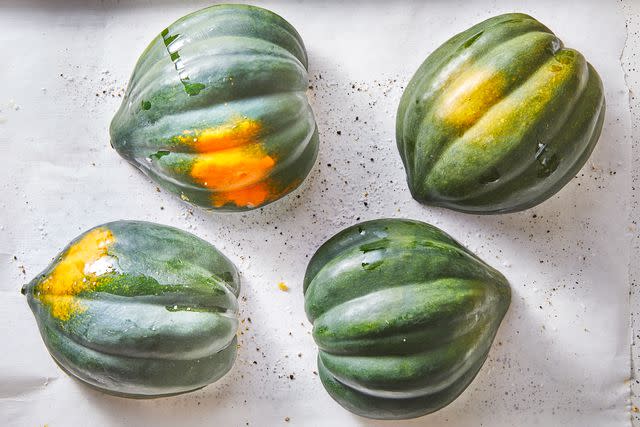
Caitlin Bensel, Food Stylist: Torie Cox
Less sweet than other winter squash, this mild-flavored variety is suitable for all sorts of savory applications. Shaped like an acorn, this squash has deep ridges that run from the stem to the base and dark-green skin, which also features an orange splotch on one side. The skin is tough and usually discarded after cooking as it's tough to peel when the squash is raw.
Inside, the buttery flesh is a golden yellow-orange color. It's in season in the fall and early winter, but can often be found at grocery stores year-round. Look for dull skin when purchasing, as shine indicates the squash is underripe. It's suitable for stuffing, roasting, steaming, and even soup. It's delightful just served on its own, slow-roasted, and topped with butter, too.
Related: Acorn Squash Soup
Red Kabocha
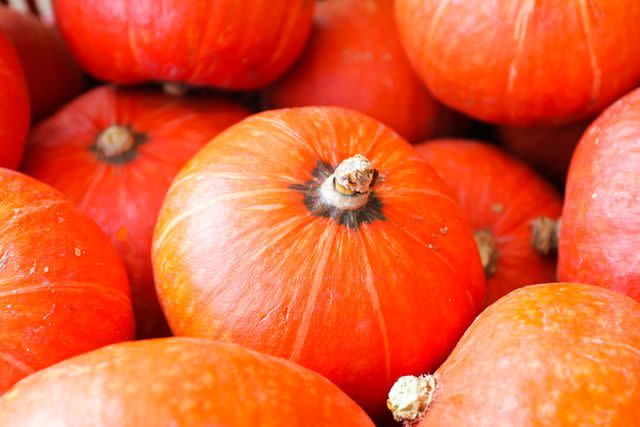
hlehnerer/Getty Images
Red kabocha squash, at first glance, might look like pumpkin, but it has thin white lines running along the skin from stem to base. This squash can be used interchangeably with its closely related cousin, the green kabocha squash (more on that below), but it is noticeably sweeter. You can eat the skin of this vibrant squash or choose to remove it. Inside, it has deep-orange flesh that is visually reminiscent of pumpkin and has a similar flavor, too.
Green Kabocha
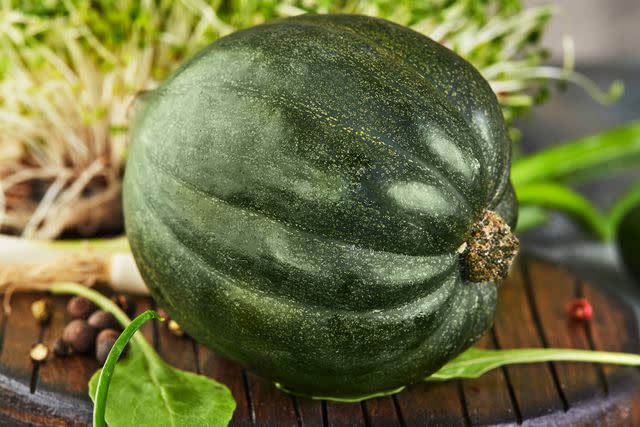
Alexander Donin/Getty Images
This rich but starchy variety is one winter squash that benefits from a long simmer, which helps bring out its natural sweetness. The flesh is orange and fluffy, which might remind you of a sweet potato. The rough green skin isn't as tough as you might expect it to be, so it can be left on, although for smooth purees and soups it should be removed. This variety is widely used in many Asian cuisines, including Japanese cooking. This kind of kabocha is distinctly more savory than the closely related red kabocha.
Hubbard
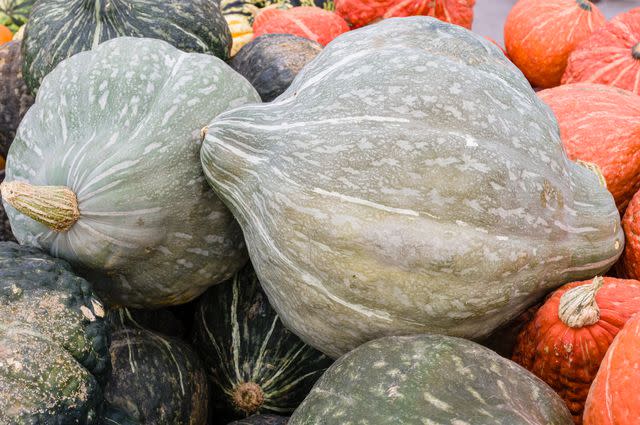
Jatrax / Getty Images
Hubbard squash come in a wide range of colors (orange, blue, gray, and more) and are one of the larger winter squash you can buy, with some growing up to 20 pounds. In terms of cooking, opt for squash in the smaller 3- to 5-pound range. These squash have thick skins that allow for a long shelf-life of six months or more when properly stored. It also means they are difficult to peel, so cook them with the skin on. The squash is ideal for baking and also stuffing, much like acorn squash.
Related: Spicy Blue Hubbard Squash Soup
Red Kuri
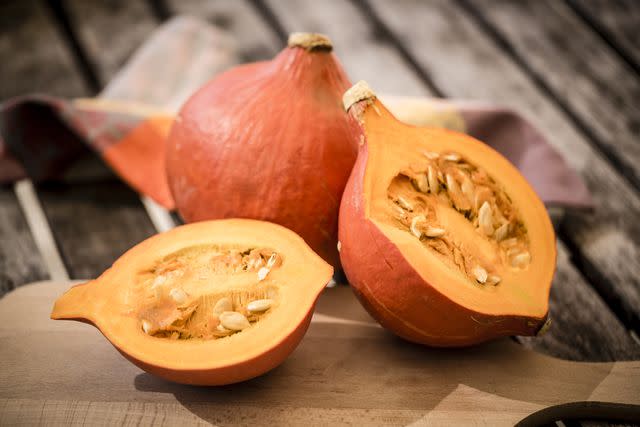
Red kuri squash, also called orange Hokkaido squash or pumpkin, are a thin-skinned variety with a bright orange exterior and a teardrop shape. The flesh is mildly sweet and has a chestnut-like flavor (kuri means chestnut in Japanese). On the smaller side, they typically weigh around 3 to 5 pounds but can be slightly larger. They are difficult to peel, so they are cooked with their skin on, which becomes soft once cooked. The smooth flesh is well-suited to soups, but it can also be roasted whole or stuffed much like an acorn squash.
Sweet Dumpling
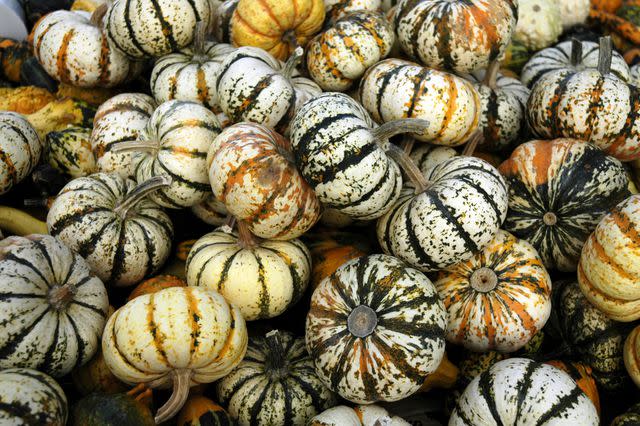
Like delicata, this squash variety has edible striped skin, which is a good thing because it's a tricky squash to peel given its many ridges. Its flesh is a little drier than other winter squash, and it has a yellow-orange hue. It tastes sweet (as the name alludes, although you might find it labeled simply "dumpling squash") and has a creamy texture. It's well suited for any recipe calling for winter squash and makes for a beautifully smooth squash soup.
Spaghetti
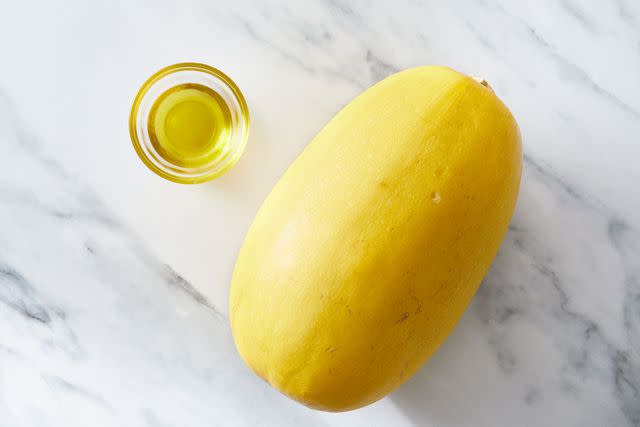
Caitlin Bensel; Food Stylist: Torie Cox
Earning its name from the spaghetti-like texture of its stringy flesh, spaghetti squash is a staple of lower-carb cooking and those that just enjoy its unique texture. With a firm, smooth yellow skin and a matching yellow interior, this squash is instantly recognizable in the grocery store. It's best roasted until tender, and for the longest "noodles" possible, sliced in half lengthwise. It can be served with marinara just like pasta or incorporated into a cheesy casserole.
Carnival

Firn/Getty Images
This variety is a hybrid of acorn and sweet dumpling squash. It can be stuffed and roasted just like an acorn squash and can be used in its place in most any recipe. At the store, look for its characteristically striped and speckled skin, with hues of cream, orange, and green. After harvesting, the green color slowly fades, leaving only the cream and orange colors behind. Inside the small squash is a sweet and buttery orange flesh. Catch them at your local market in early fall through winter like most hearty squash varieties.
Sugar Pumpkin
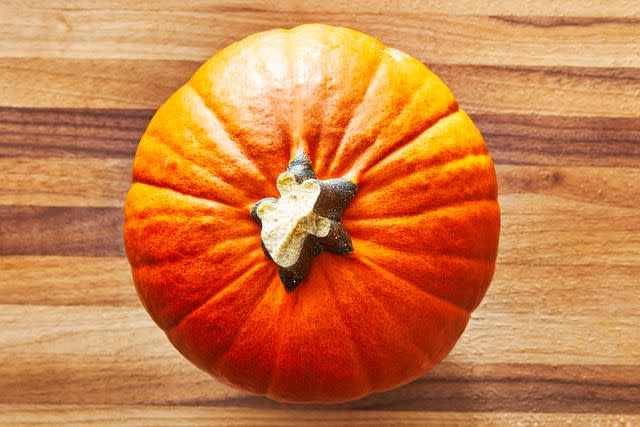
Caitlin Bensel, Food Stylist: Torie Cox
This Halloween staple is the stuff that pie dreams are made of. Literally. It's often used to make the pumpkin puree that we bake up into a custardy dessert every Thanksgiving. It's also good for so much more than dessert. These pumpkins are prized for their sweet, dry, and firm flesh, which is delicious in soups and stews.
Smaller than the pumpkins used for carving, you might see them labeled as sweet pumpkins, sugar pie pumpkins, or pie pumpkins at the store. Roasting this squash helps bring out its sweetness, but it's also delicious steamed, simmered, or sautéed.
Related: How To Make Homemade Pumpkin Puree
White Acorn
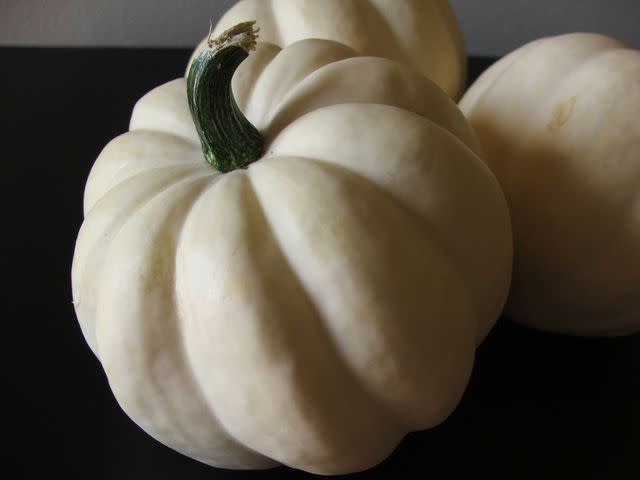
RighteousSeeds/Getty Images
This is a fairly new winter squash variety that was developed in the 1980s by squash collector and expert Glenn Drowns. Also called mashed potato squash, it's best suited for roasting and baking, and can be used in sweet and savory dishes. It has a smooth white skin, deep ridges, and pale yellow flesh, which has a fairly mild, sweet flavor with hints of hazelnut and pepper.
It pairs nicely with other fall flavors like apple, maple syrup, and cinnamon, but it can also stand up to strong flavors like chili powder and sharp cheeses. This is a squash you likely won't find at your average grocery store, so look for it at farmers' markets.
Banana
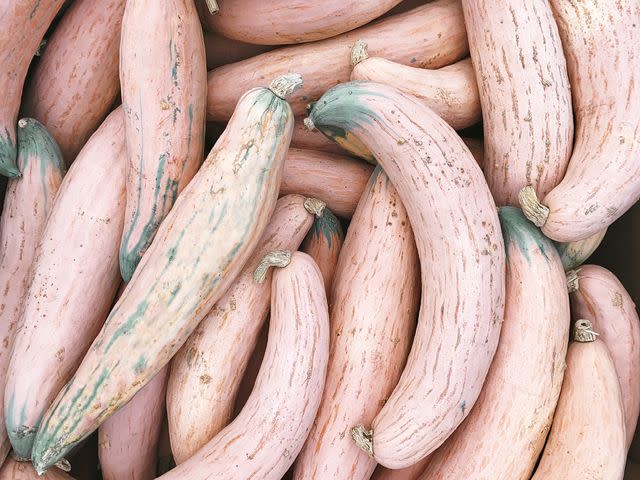
Melissa Ross/Getty Images
Named for their oblong shape reminiscent of the eponymous fruit, banana squash come in a variety of colors including the beautiful pink featured above, although the skin can also be blue, yellow, or multicolored. They can grow to be extremely large, sometimes as long as almost 3 feet. Inside the flesh is orange, dense, and firm. When cooked, it's rich, earthy, and mildly sweet.
While you've likely not encountered this giant squash at your local supermarket, it was extremely popular in the early 20th century but then faded in favor of modern, smaller varieties like butternut. If you do get your hands on one, it can be used in place of butternut squash in most culinary applications for a fun twist on a classic recipe.
Turban

Getty Images
This medium- to large-sized winter squash is named for its irregular turban shape on one end. Its tough, bumpy skin is orange, green, yellow, and white, and the yellow-orange flesh has a sweet, nutty flavor that makes it well-suited for fall stews and casseroles. The thick skin makes it hard to peel, so leave the skin on during roasting and then remove the flesh, or steam the squash for a few minutes to help remove the skin more easily. This squash can grow to 10 to 15 inches in diameter up to 5 or 6 pounds. Since this squash has a more bland flavor than other types, it's most often used as seasonal decor instead of in recipes, but it can be used in soups, pasta dishes, or pumpkin pies.
Related: 15 Types Of Squash: Your Guide To Winter And Summer Squashes
For more Southern Living news, make sure to sign up for our newsletter!
Read the original article on Southern Living.